| What is it? |
-
This is a specific type of injury of the joint where the thumb joins the
palm, on the index finger side of the thumb.
|
| What caused it? |
-
Usually, a fall, some how catching the thumb on the way down. When skiing,
the thumb may be injured in a fall, caught in the ski pole loop - referred
to as a "ski pole thumb" - the same injury.
|
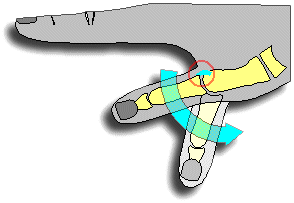 |
When the thumb is pushed sideways away from the index finger,
the ligament connection between the bones may be torn. Usually, just the
ligament is torn, but a small chip of bone may be torn off as well. |
-
Actually, the name "gamekeeper's thumb" is an old expression, referring
not to a sudden injury, but to stretching this ligament out over a long
time by pushing hard again and again - doing a particular thing that gamekeepers
used to do by hand...
| Here's the ligament location on the index finger side of the right
thumb. |
 |
| Here's the same thumb from the top, showing the real problem.
The ligament is usually covered by a sheet of tissue, like canvas. In some
people, when the ligament tears, a hole tears in this sheet as well. The
end of the ligament can poke through this hole, where it stays trapped. |
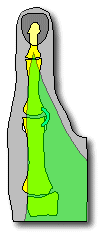 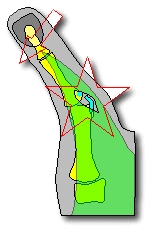 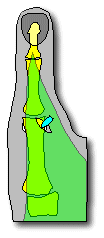 |
| The torn end of the ligament is blocked from getting back to its original
location - so it can not heal on its own. The thumb may lose strength,
and in the long run, the abnormal side to side movement of this floppy
joint will lead to a permanent bend in the joint, arthritis, or both. |
 |
| What can you do to help? |
-
Ice, elevation, and have it checked out by a doctor. If the thumb is bruised
at this joint, it is likely that you broke or tore something - and you
should have it looked at.
|
| What can a therapist do to help? |
-
Depending on the problem, a therapist can be very helpful in providing
a protective splint and supervising special exercises to improve movement
and strength.
|
| What can a doctor do to help? |
-
Confirm that this is the problem. X-rays are usually needed to show exactly
what and how bad the problem is - .
-
Treatment really depends on the type of injury Your doctor may recommend:
-
moving the fingers and doing exercises right away
-
wearing a splint or a cast
-
having surgery to repair the ligament (or the bone chip), possibly using
hardware (pins, screws, wires, etc.) to hold the joint in place.
|
| Technically, it may be difficult to reattach the ligament to the bone,
and there are several ways to do this. One involves using a small harpoon-like
metal anchor which stays permanently in the bone. |
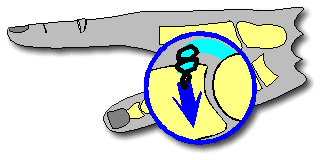 |
| How successful is treatment? |
-
The great majority of people who have surgery for an unstable gamekeeper's
thumb are better off than if they had not had surgery. The longer one goes
between injury and surgery, the less likely things will be great after
surgery. The biggest problems people have, with or without surgery,
are stiffness and some pain with use. This is true for any significant
injury of this joint.
|
| What happens if you have no treatment? |
-
It's a roll of the dice. You may luck out and wind up with a pretty good
result. You may do well, then develop painful arthritis of the joint years
later. Surgical repair is technically possible for many months after injury,
but results of late intervention are not as reliable, and usually not as
good.
|
|






